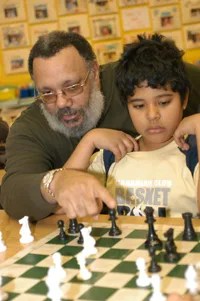To celebrate its 10th anniversary, The After-School Corporation (TASC), based in New York City, asked highly accomplished individuals what they did after school when they were growing up. The organization suspected many stars discovered their true passions during the hours between school and dinnertime, or were shaped by their adventures and creative awakenings.

Child who attends the Abundant Waters after-school program at PS 51 in Manhattan learn chess from master Chris Welcome.
The responses TASC received were heartfelt. Drew Gilpin Faust, the president of Harvard University, recalled raising cattle, but also Brownies and ballet. When he was just a tyke, Neil deGrasse Tyson, the current director of the Hayden Planetarium at the Museum of Natural History, took after-school classes at Hayden Planetarium. Actor and Park Slope parent John Turturro said he played endless basketball with his Brooklyn buddies. Judith Jamison, the dance star and artistic director of Alvin Ailey American Dance Theater, recalled “piano lessons, playing violin and, of course, dance class.” She said, “Looking back at my after-school experiences, I realize how important they were to my personal and professional journey.”
TASC was the first nonprofit in the nation to set out to build a citywide K-12 after-school system. It supports free after-school programs that operate every day, 3-6pm, in New York City’s public schools in all five boroughs.
Research bears out the formative influence of after-school activities – not surprising, given that kids spend less than a quarter of their waking hours attending school. Recently the Harvard Family Research Project reviewed 10 years of research on high-quality after-school programs that exposed kids to a variety of arts, sports and academic experiences. The team concluded that kids who regularly attended such programs improved their work habits, attitudes, school attendance and achievement. They also had fewer behavioral problems.
In 1998, the number of New York City kids enrolled in daily, complete after-school programs was 10,000. Today it’s 140,000. In 1998, all levels of government invested about $60 million in support of these programs. Since then, Mayor Michael Bloomberg has launched the Out-of-School-Time initiative to expand after-school programs, and public funding has more than quadrupled to $295 million annually. Hundreds of thousands of New York kids, however, still lack access.
Of course New York offers a cornucopia of exciting and inspiring after-school activities to families that can afford to pay for lessons and other experiences. Not all families want free, school-based programs. But as the quality and program offerings grow stronger each year, working parents are seeking out schools that offer them.
All forms of dance, sports and visual arts remain popular after school. Students hunger after literacy programs that encourage them to read for pleasure books of their choosing, and to combine writing with art and family projects, like creating family histories.
Hands-on science exploration and community service-learning projects are growing more popular. Parents know their kids need more time to delve into science and technology experiences that will prepare them for 21st century careers. After-school programs present science in fun and intriguing ways, such as forensic projects that echo techniques popularized through the CSI TV programs. By one count, three-quarters of the kids who attend after-school programs supported by the main federal funding source are working on science.
Community service-learning projects tap into kids’ natural inclinations to be heroes. Many help kids to become healthier athletes and eaters, and to encourage their families and neighbors get healthier, too. Kids from PS 64 in the Bronx helped TV’s “Iron Chef” Cat Cora prepare a lunch of watermelon gazpacho, whole grain pasta and fruit parfaits at the Children’s Museum of Manhattan earlier this year.
Also on the horizon are programs that expand the school day or year to help kids learn more and learn differently, including through arts and sports. TASC is working with about 10 public schools this coming year, through the Expanded Learning Time/New York City program, to enhance the school day or year so that teachers and after-school specialists are working together toward the same goals for kids. Hopefully more and more kids will discover the passions and talents that could make them the next generation of great entrepreneurs, artists, and university presidents.
SUSAN BRENNA is the director of communications for The After-School Corporation (TASC), a nonprofit organization that works for all kids in New York City and beyond to have enriching and high-quality music, arts, sports and expansive learning experiences beyond traditional school hours. To learn more about after-school in New York or to read about the after-school experiences of star achievers, visit www.tascorp.org.





















